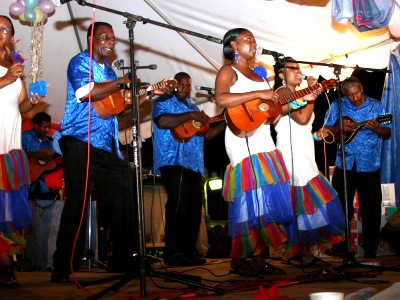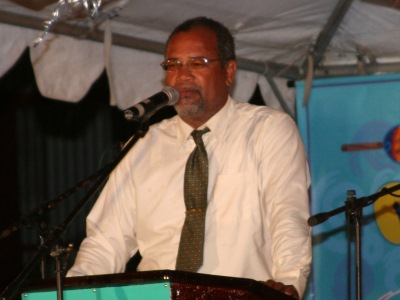|
|
|
The Art of Trinidad and Tobago
|
Origins and Nature of Parang Music
Staff Article
November 24, 2005
Parang Music has long been associated with Christmas festivities. The word parang originally came from the word 'paranda' meaning merry making. Traditional parang bands made up of parenderos consist of singers and musicians who play the guitar, the mandolin, the cuatro, the violin, the maracs, the clapper, the box bass, the tambourine, the scratcher (güiro) and the toc-toc (claves). Other non-traditional instruments such as the dolak and the steelpan are sometimes included but this has caused some controversy within the Parang fraternity.
The African aspect of Parang is what gives it a unique flavour. In a Trinidad Guardian article written in 1971, John G. Cupid wrote:
Musicologists do not hesitate to credit the contribution to Parang made by West Africa through their descendants in Trinidad. The "tense nasal Spanish singing style was modified by the relaxed West African voice timbre with its varied intonation."
The instruments used were mainly string - violin, bando, mandolin, quatro and guitars - to which was added the box drum or box bass which is a variation of the African (zanza mbira).
In an interview with Triniview.com, the President of the National Parang Association, Michael Lezama spoke about the origins and nature of Parang Music as well as the challenges facing the artform. He noted that there are two theories about the origins of Parang Music. The first theory is that Spanish monks, who were here to indoctrinate people into Catholicism, first introduced the music that is now popularly known as 'parang'. The second theory is that Venezuelans who migrated to Trinidad, fleeing persecution during the Bolivarian Revolution brought the first elements of parang to Trinidad. Lezama explained that because of the up-tempo beat of parang it is unlikely that the Spanish monks brought parang to Trinidad, but that they influenced the artform, especially in terms of enunciation and the message of parang which was to teach Biblical scriptures in song.
Parang is played mainly around Christmas time, but Lezama noted that this was not always so. In the days when 'cocoa was king', when there was no radio or even electricity, Parang Music was one of the main forms of entertainment on the cocoa estates. Areas such as Lopinot, Rio Claro, San Raphael, Palo Seco and Arima have been traditionally associated with Parang. As head of the Parang Association, Lezama outlined that his organization is making strong attempts to move parang from being a seasonal (Christmas) artform. He wants to see parang played all year and accepted as a legitimate artform.
The traditional parang songs are Christian and are sung in Spanish, but there are also secular styles of parang which are known as Aguinaldos and Despendidas. Within the last several years Soca has been fused with parang giving birth to a new variant of parang called 'Parang Soca'. With Parang Soca came English lyrics being sung to the traditional rhythmic patterns. Lezama acknowledges that artforms will evolve but he emphasized that the National Parang Association is dedicated to preserving parang in its purest form. With regards to Soca Parang and the fusion of other music with parang he sees these as being different from traditional parang. Noting that fusion can be good, he disclosed that his band, 'San Jose Serenaders', has been the first to incorporate the dholak into Parang Music.
In respect to the pan being incorporated into parang, Lezama says that there are a couple of parang bands that have incorporated pan, but that this is being met with stiff resistance from die-hard parenderos within the Association. Lezama mentioned that there is still a lot of the subtle prejudice against pan in Trinidad and Tobago. Interestingly, he emphasized that while the official position of the National Parang Association is that pan should be excluded from parang, his personal position is that it should be included, and the sooner the better.
The National Parang Association has been in existence since 1971 and has a mandate to ensure the longevity of Parang in its purest form. One of their yearly activities is the Annual Parang Festival which serves to create an awareness of Parang in the national community. Additionally, the National Parang Association has been having a Schools Parang Competition since 1992. Lezama disclosed that he has held discussions with the Ministry to introduce Parang in the classroom program. With Spanish having been introduced throughout the primary and secondary school system, he observes that parang will be easier for the children to accept.
In terms of Government support, Lezama, who has been the President of the National Parang Association for the past two years, said that while support is given to the Association, it is not sufficient. The government is currently renovating their Headquarters in Arima, and he is thankful for this help. However, the general financial support that the Association gets does not even cover the prizes for the Parang competitions. Lack of finances he says, has prevented the National Parang Association from being able to respond properly to citizens who may be searching for information about parang.
Speaking on the issue of copyright infringements, Lezama deplored the fact that pirates are selling pirated Parang Music with impunity. Copyright infringements are causing artistes to suffer tremendously as they are putting out a lot of money to produce the music and not getting back the returns. He said there are loopholes in the Copyright Act and that the stakeholders are currently working to address them.
Lezama lastly outlined some of the other plans of the National Parang Association that are in line with their mandate:
- A plan to revive Parang in Lopinot, which was once a stronghold of parang, by having monthly parang shows in Lopinot.
- Having Parang on the road for Carnival 2006.
- Encouraging radio stations to play Parang Music all year round.
- Properly marketing the Parang events of the Association to attract wider support.
- Initiating a program to have mandolin and violin tutors in schools.
- Exporting Parang Music.
- Getting Parang Music accepted as a genre of music in the Latin Grammy Awards.
Parang, with the help of the government and the people of the Trinidad and Tobago, can become an internationally renowned musical artform enjoyed the world over.
Parang Festival 2005 Album:
www.trinisoca.com/gallery/parang
There's More To Parang
Parang Instruments
|

|

